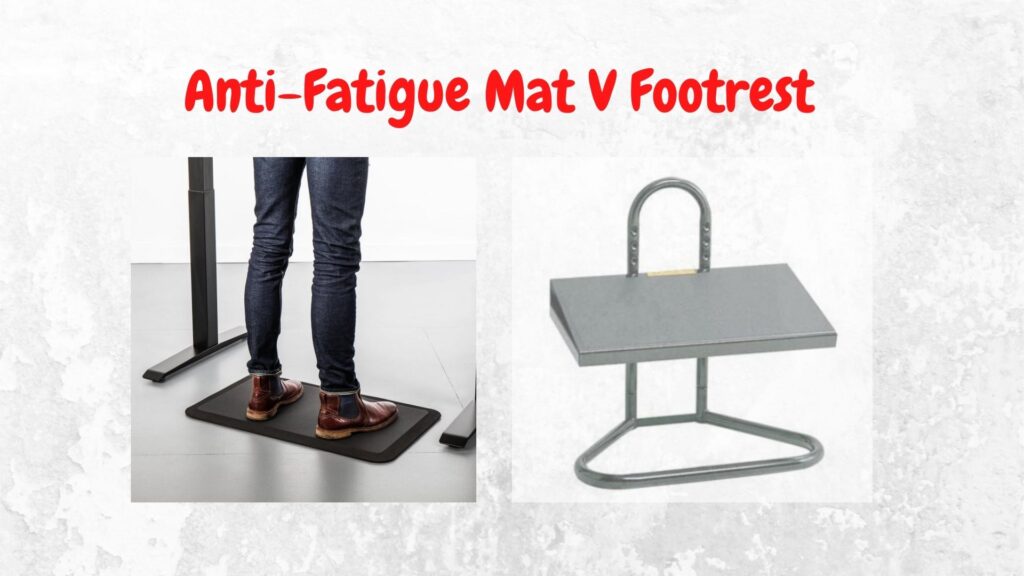Staying in a static position for too long, be it sitting or standing, can cause negative health effects and discomfort. This article investigates the differences between anti-fatigue mat v footrest. These are two common support aids that people use to relieve them for pain and discomfort. So, which of them should you opt for? Stay tuned to find out!
If you’re in a hurry, here is a site I recommended for office equipment with lifetime guarantee!
Anti-Fatigue Mat V Footrest
| Feature | Anti-fatigue mat | Footrest |
| Purpose | Support while standing | Support while sitting or leaning |
| Level of support | High | Low |
| Cost | $4 – $185+ | $15.99 – $311 |
| Durability | High, suitable for work environments | Low, suitable for indoor use |
| Weight | 2.74 – 13.23 pounds | 1.6 – 7.05 pounds |
| Weight capacity | 300 pounds | None |
| Safety features | Multiple | Few |
| Material | Polyurethane foam, gel, vinyl, rubber | Foam, plastic, leather |
| Size | Small, medium, large | Small, medium, large |
| Style | Limited functional design | Variety of styles, shapes and colors |
The International Labor Organization recommends using footrests to reduce back strain. Source
As you can see, footrests are designed for use while sitting while standing mats are best for standing for long periods. But there’s more to each unit than just that! Let’s look at the other key factors to see which of them is the best option for you!

Purpose
Whether you need support for standing or sitting will usually be the defining factor in whether you choose a standing mat or a footrest.
Anti-fatigue mats are designed to reduce fatigue in the lower body for people who stand for long periods throughout the day.
In contrast, a footrest has a primary function of providing a surface for your feet to rest on while seated. Especially when your feet can’t reach the ground or while leaning against a stool.
It also assists in improving your posture while you sit.
Level of support
Anti-fatigue mats provide a higher level of cushioning and shock absorption which enables you to stand with reduced feelings of fatigue and discomfort.
That fatigue-reducing capability is more important for standing mats as the weight of your whole body will be placed on the mat.
Footrests, on the other hand, require less cushioning and many of them have a hard surface.
What’s becoming more popular is footrests with anti-fatigue foam.
This provides a more comfortable experience, especially when you are using the footrest in your barefoot or in socks.
The level of cushioning won’t be as important as it would be on a standing mat.
Cost
Anti-fatigue mats have a price range between $4 – $185+. In comparison, a footrest can start anywhere from $15.99 and reach prices as high as $311+.
The majority of the time, it will be cheaper to opt for a footrest instead of a standing mat.
However, instead of comparing them by cost, anti-fatigue mats and footrests should be purchased based on if you need the support for sitting or standing.
Find out here what I uncovered when I investigated Are Anti Fatigue Mats Worth It? 11 Unexpected Pros & Cons!
Durability
Anti-fatigue mats are designed to different levels of durability. It tends to be based on the duration that the anti-fatigue mat will be used for. This means that they should be suitable for places where they will be used even for long hours throughout the day.
| Type of anti-fatigue mat | Duration of use | Environment suited to |
| Light duty | < 4 hours a day | Office, reception |
| Medium duty | 4 – 6 hours a day | Kitchen, office |
| Heavy duty | > 6 hours a day | Kitchen, workshop, assembly line, outdoors |
The fatigue-reducing mat should bounce back to its original shape once you shift your weight off it.
This is an important consideration when choosing a quality anti-fatigue mat.
Fatigue-reducing mats can also be resistant to spills, stains, hot objects and punctures.
In general, anti-fatigue mats have a lifespan of approximately 2 years.
However, if you opt for the Safco Movable Anti-Fatigue Mat, you can get a lifetime warranty.
In contrast, you should expect under desk footrests to last for years, unless you misuse it.
Ergofoam even offers a lifetime warranty with their foam footrests!
A key element is to decide if you intend to use the footrest in your socks or with shoes.
If you’re using shoes, the footrest foam could become dirtied easily. There is a removable footrest cover that you can wash. This is where plastic footrests would be more suitable as they are easier to clean.
The risk of dirtying a foam footrest could be minimized by having indoor shoes or even desk shoes which would have a clean sole.
Or just opt for not wearing shoes while using the footrest.
If the smell of your feet is not going to knock half the office out, that is…
Weight
Anti-fatigue mats have weights starting around 2.74 and can reach weights up to 13.23 + per m2.
If you’re getting a large strip of industrial anti-fatigue matting, this will weigh more than a standard sized standing mat.
Footrests have weights ranging between 1.6 – 7.05 pounds which makes them very lightweight and extremely portable.
Weight capacity
When purchasing an anti-fatigue mat, you’ll notice that there is a weight limit provided. This indicates how much pressure the standing mat can withstand without becoming subject to sinking or damage.
Anti-fatigue mats can hold weights as high as about 300 pounds.
On the other hand, there are very few footrests that come with a weight limit.
They don’t generally need one anyway, because you are only meant to be resting your feet on them, not the weight of your body.
Safety features
Anti-fatigue mats can be used in a wide range of environments including:
- Homes
- Offices
- Gaming rooms
- Kitchens
- Workshops
- Outdoors
- Cleanrooms
- Labs
- Electrical workplaces
To tolerate the elements of such environments, you can choose the properties of the anti-fatigue mats so that it is suited to that area.
Safety features that industrial anti-fatigue mats have include:
- Anti-slip
- Drainage built in
- Fire resistant
- Chemical resistant
- Oil resistant
- Anti-static
With a footrest, there will be less choice in terms of features available. That said, a key component to look for is a non-slip grip. The last thing you want is for the footrest to slide around underneath you!
Material
Anti-fatigue mats are generally made from polyurethane foam, gel, vinyl or rubber. These are durable materials with cushioning properties.
High density memory foam is a popular choice for anti-fatigue mats.
Footrests are made from a variety of materials including:
- Foam
- Plastic
- Leather
Size
Standing mats are available in compact sizes suitable for standing one person on. Small sizes start around 17 x 24 inches while larger standing mats measure around 24 x 70 inches.
They can range all the way up to rolls which are suited to workshops or more industrial environments.
Footrests come in small, medium and large sizes to accommodate different sized feet.
They also tend to come in an angled square adjustable platform or a dome, whereas anti-fatigue mats tend to be square or rectangular.
Tip: Dome-shaped footrests can also be used under your knees on the couch or in bed.
Style
Anti-fatigue mats tend to be designed with functionality and safety in mind. They are normally available in a black color and have limited aesthetic designs, especially industrial anti-fatigue mats.
Footrests are the leaders on the style front.
Related: Balance boards vs anti-fatigue mat – cheat sheet included
Conclusion
As you can see, the anti-fatigue mats and footrests have two very different purposes. Ultimately, whether you opt for a standing mat or an under-desk footrest boils down to whether you need support for standing or sitting.
You might decide that you need both, one while at a standing task (or standing desk) and one while you sit.
If you’re still not sure or would like further dive into the many benefits of anti-fatigue mats, I have written some articles worth a look.
Here are some other useful articles I wrote that you should go check out:
- How do anti-fatigue mats work? With FAQs & Helpful Tips!
- What Are Anti-Fatigue Boots? – Complete Beginners Guide!
- Are Anti Fatigue Mats Worth It? 11 Unexpected Pros & Cons!
- Anti-Fatigue Mat V Insole – 10 Factors Plus Quick Comparison
- Anti-Fatigue Mat V Carpet – A Quick & Simple Comparison!
Recommended Products:
- Task Master Adjustable Footrest (link on OfficeFurniture2Go)
- ComfiLife Foot Rest (link on Amazon)
- Mind Reader Footrest (link on Amazon)
- Platinum Indoor Floor Mat (lifetime warranty) (link on OfficeFurniture2Go)
- Anti-fatigue comfort mat with lifetime warranty (link on OfficeFurniture2Go)
